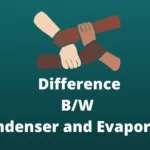A knuckle joint is a form of pin joint that is used to connect two tension-loaded components. Otherside, A cotter joint, also known as a socket and spigot joint, is a way of connecting two coaxial rods temporarily.
Here, Engineers Rail extends their warmest welcome to you. We’ll look at Difference between Knuckle joint and Cotter joint in this post.
Come with me, if you want to understand more about it. I hope this will help you add a few more drops to your knowledge tank.
Let’s get this celebration started as quickly as possible…

Difference between Knuckle joint and Cotter joint:
In the table below, you’ll find some essential distinctions between these joints:
| S.No | Knuckle joint | Cotter Joint |
| 01. | The knuckle joint connects two rods whose axes either coincide or intersect and lie in the same plane and are subjected to axial tensile force transmission. | The cotter joint connects two co-axial rods that are subjected to axial force. |
| 02. | When angular displacement is required, a knuckle joint is employed. | When there is no angular displacement between two rods, a cotter joint is utilized. |
| 03. | The knuckle joint is designed to handle high-tensile loads. | For minor tensile and compressive forces, cotter joints are utilized. |
| 04. | Allow for angular movement between the rods. | Allowing angular movement between rods is not permitted. |
| 05. | Even when two shafts are in motion, a Knuckle joint is designed to enable certain mobility or angle between them. | The cotter joint is designed to help aligned shafts rotate in the same direction. |
| 06. | There is no taper or clearance offered. | Clearance and taper are included. |
| 07. | Bearing failure is a common incident. | Bearing failure is not a problem |
| 08. | Part of the Knuckle Joints are the fork end, Rod end, Split pin | Part of the Cotter Joints are the cotter, spigot, socket |
| 09. | A circular pin is used in the knuckle joint | A rectangular pin is used in the cotter joint. |
| 10. | Used in tie bars, bicycle chain links, and all shifting mechanisms’ joints. | Used to unite two rods with a pipe, and to join the piston rod to the crankshaft head in cotter foundation bolts. |
Related Article- Cotter Joint: Definition, Types, Applications, Advantages, Disadvantages
Related Article- Knuckle Joint | Definition | Construction | Design | Applications and More
Related Also- Universal Joint: All you need to Know
Final Thoughts-
These were some of the distinctions I made in the Difference between Knuckle joint and Cotter joint above.
I hope you enjoyed your journey with me up to this point. If so, please share this information with your colleagues, friends, and those in need by clicking the share button below.
Engineers Rail should be added to your favorites list so you may ride it more often. I look forward to seeing you soon.
Thank you for taking the time to listen to me.
You might also be interested in reading about the following differences:
What is Mechanical Pin?: Classifications, Types, Uses with Pictures
Difference between Jet condenser and Surface condenser
10 Differences between Laminar and Turbulent Flow
Difference Between Conventional and Non-Conventional Machining Processes

Abhishek Tiwary is a blogger by passion and a Quality Engineer by profession. He completed his B.Tech degree in the year 2017. Now working in a reputed firm. He loves to share his knowledge with others.


![Difference between Orificemeter and Venturimeter [With PDF] Difference between Orificemeter and Venturimeter [With PDF]](https://www.engineersrail.com/wp-content/uploads/2021/09/difference-between-orificemeter-and-venturimeter-150x150.webp)
